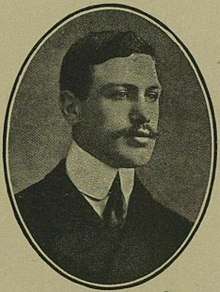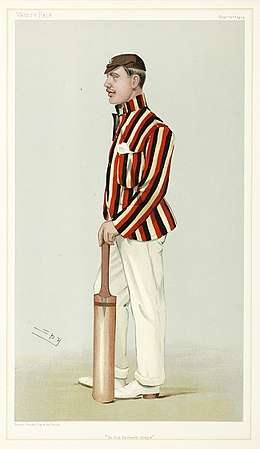Harry Primrose, 6th Earl of Rosebery
| The Right Honourable The Earl of Rosebery KT DSO MC PC FRSE | |
|---|---|
 | |
| Secretary of State for Scotland | |
|
In office 23 May 1945 – 26 July 1945 | |
| Monarch | George VI |
| Prime Minister | Winston Churchill |
| Preceded by | Thomas Johnston |
| Succeeded by | Joseph Westwood |
| Member of Parliament for Midlothian | |
|
In office 1906–1910 | |
| Preceded by | Alexander Murray |
| Succeeded by | Alexander Murray |
| Personal details | |
| Born | 8 January 1882 |
| Died | 31 May 1974 (aged 92) |
| Nationality | British |
| Political party |
Liberal National Liberal |
| Spouse(s) |
Dorothy Grosvenor (m. 1909; div. 1919) Dame Eva Bruce (m. 1924) |
| Children | 3, including Archie and Neil |
| Parents |
Archibald Primrose, 5th Earl of Rosebery Hannah de Rothschild |
 | |||||||||||||||||||||||||||
| Cricket information | |||||||||||||||||||||||||||
|---|---|---|---|---|---|---|---|---|---|---|---|---|---|---|---|---|---|---|---|---|---|---|---|---|---|---|---|
| Batting | Right-handed batsman | ||||||||||||||||||||||||||
| Bowling | Right arm fasta | ||||||||||||||||||||||||||
| International information | |||||||||||||||||||||||||||
| National side | |||||||||||||||||||||||||||
| Career statistics | |||||||||||||||||||||||||||
| |||||||||||||||||||||||||||
|
Source: CricketArchive | |||||||||||||||||||||||||||
Albert Edward Harry Meyer Archibald Primrose, 6th Earl of Rosebery, 2nd Earl of Midlothian, KT, DSO, MC, PC, FRSE (8 January 1882 – 31 May 1974), styled Lord Dalmeny until 1929, was a British politician who briefly served as Secretary of State for Scotland in 1945.
Early life and education
He was born at Dalmeny House west of Edinburgh on 8 January 1882. His parents were Archibald Primrose, 5th Earl of Rosebery, Liberal Prime Minister of the United Kingdom (from 1894–95) and Hannah Primrose, Countess of Rosebery, a member of the Rothschild family.[1]
He was the brother of Neil Primrose and the writer Lady Sybil Grant.
He was educated at Eton then undertook military training at the Royal Military College, Sandhurst.[2]
Military career
Lord Dalmeny was commissioned into the Grenadier Guards as a Second lieutenant 12 February 1902.[3]
During the First World War, he served in France from 1914–17 as Camp Commandant and ADC to General Allenby and subsequently in Palestine as Allenby's Military Secretary.
Cricket career
As Lord Dalmeny he was a prominent cricketer and he played two first-class matches for Middlesex in 1902. He served as captain of Surrey County Cricket Club (1905–1907). He played in 102 first-class matches in all, scoring 3551 runs at an average of 22.47, including 2 centuries with a highest score of 138. He was a hitter of notable power[4] and though never consistent he could on occasions “knock the best bowling all over the field”, as when he hit 58 against Hallam on a difficult wicket at The Oval in 1905. Rosebery was notable in horseracing circles for winning The Derby with Blue Peter and Ocean Swell, and winning most other classic British flat races, with horses bred at his Mentmore and Crafton Studs.
Political career and later life
He commenced his political career by being elected Liberal Member of Parliament for the Scottish seat of Edinburghshire. This was a county, better known by its modern name of Midlothian, which was an area where the Roseberys had long been prominent landowners. Dalmeny was one of almost 400 Liberals returned in the great landslide victory of the 1906 election. He retired from the House of Commons in January 1910. At the time of his death he was the last survivor of the 1906 Liberal MPs.
Rosebery entered the House of Lords on the death of his father in 1929. The same year he was appointed Lord Lieutenant of Midlothian, a post he held until 1964.
In 1938 he was elected a Fellow of the Royal Society of Edinburgh. His proposers were Hugh Macmillan, Baron Macmillan, Sir Thomas Henry Holland, James Pickering Kendall and James Watt..[5]
In February 1941, during the Second World War, he was appointed Regional Commissioner for Civil Defence in Scotland. When the wartime coalition government broke up in 1945, Winston Churchill formed a caretaker administration to hold office until the 1945 general election. The new government was composed of members of the Conservative Party and the small groups which had allied with it in the National governments in office 1931–1940. Amongst these allies was the National Liberal Party to which Rosebery belonged.
One of the most unexpected appointments Churchill made was to install Rosebery as a member of the Privy Council and Secretary of State for Scotland. Both men had served together in the Liberal Parliamentary Party in the 1906–1910 Parliament. The caretaker Ministry was in office May to July 1945. So brief was his tenure at the Scottish Office that during the Royal Commission on Scottish Affairs (1952-4) he declined to give evidence on the grounds that he did not know what to say.[6] Reputedly, his last words prior to his departing from the Scottish Office were "Well. I didn't make a bad job of this, did I? Didn't have the time".[7]
He was created a Knight of the Order of the Thistle (KT) in 1947 by King George VI. Rosebery was President of the National Liberal Party 1945–1957. He was also appointed Chairman of the Royal Fine Art Commission for Scotland in 1952.
He died at Mentmore House in Buckinghamshire on 30 May 1974.[8]
Family
In 1909, he married Dorothy Alice Margaret Augusta Grosvenor, daughter of Lord Henry George Grosvenor. They had a son, Archie Primrose, Lord Dalmeny (1910–1931), and a daughter, Lady Helen Dorothy Primrose (1913–1998). They divorced in 1919. He remarried in 1924, to Dame Eva Isabel Marian Strutt (DBE), daughter of the 2nd Baron Aberdare of Duffryn. Their only child, Neil Archibald Primrose, was born in 1929.[9]
References
- ↑ Biographical Index of Former Fellows of the Royal Society of Edinburgh 1783–2002 (PDF). The Royal Society of Edinburgh. July 2006. ISBN 0 902 198 84 X.
- ↑ Biographical Index of Former Fellows of the Royal Society of Edinburgh 1783–2002 (PDF). The Royal Society of Edinburgh. July 2006. ISBN 0 902 198 84 X.
- ↑ "No. 27405". The London Gazette. 11 February 1902. p. 846.
- ↑ Pardon, Sydney H. (editor); John Wisden's Cricketers' Almanac, Forty-Third Edition (1906); p. 136
- ↑ Biographical Index of Former Fellows of the Royal Society of Edinburgh 1783–2002 (PDF). The Royal Society of Edinburgh. July 2006. ISBN 0 902 198 84 X.
- ↑ Pottinger, George, The Secretaries of State for Scotland, 1926-1976 (Scottish Academic Press, 1979), p.100.
- ↑ Young, Kenneth, Harry, Lord Rosebery, (London, 1974)
- ↑ Biographical Index of Former Fellows of the Royal Society of Edinburgh 1783–2002 (PDF). The Royal Society of Edinburgh. July 2006. ISBN 0 902 198 84 X.
- ↑ Biographical Index of Former Fellows of the Royal Society of Edinburgh 1783–2002 (PDF). The Royal Society of Edinburgh. July 2006. ISBN 0 902 198 84 X.
Sources
- Who's Who of British Members of Parliament, Vol. II: 1886–1918, edited by M. Stenton and S. Lees (The Harvester Press 1978)
- Pottinger, George, The Secretaries of State for Scotland, 1926-1976 (Scottish Academic Press, 1979)
- Torrance, D., The Scottish Secretaries (Birlinn, 2006)
External links
- Hansard 1803–2005: contributions in Parliament by the Earl of Rosebery
- The Scottish Secretaries A website dedicated to the Scottish Secretaries
- Hansard 1803–2005: contributions in Parliament by Lord Dalmeny
- David Torrance's Scottish Office blog, davidtorrance.blogspot.com; accessed 18 April 2016
- Profile, content-uk.cricinfo.com; accessed 18 April 2016
- Profile, CricketArchive.com; accessed 18 April 2016
| Parliament of the United Kingdom | ||
|---|---|---|
| Preceded by The Master of Elibank |
Member of Parliament for Midlothian 1906 – 1910 |
Succeeded by The Master of Elibank |
| Political offices | ||
| Preceded by Thomas Johnston |
Secretary of State for Scotland 1945 |
Succeeded by Joseph Westwood |
| Honorary titles | ||
| Preceded by The Earl of Rosebery |
Lord Lieutenant of Midlothian 1929–1964 |
Succeeded by Sir Maxwell Inglis |
| Peerage of Scotland | ||
| Preceded by Archibald Primrose |
Earl of Rosebery 1929–1974 |
Succeeded by Neil Primrose |
| Peerage of the United Kingdom | ||
| Preceded by Archibald Primrose |
Earl of Midlothian 1929–1974 |
Succeeded by Neil Primrose |
.svg.png)
